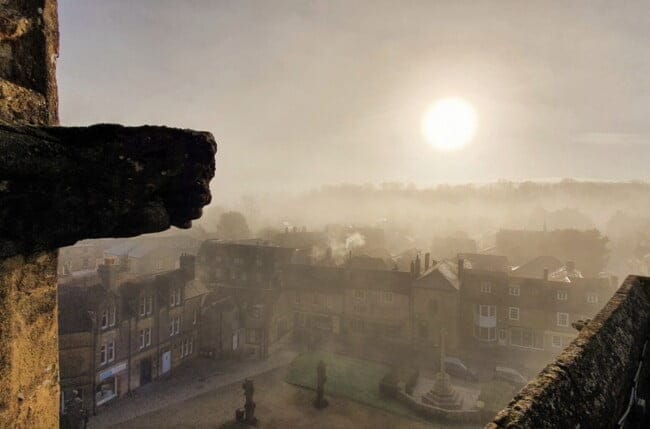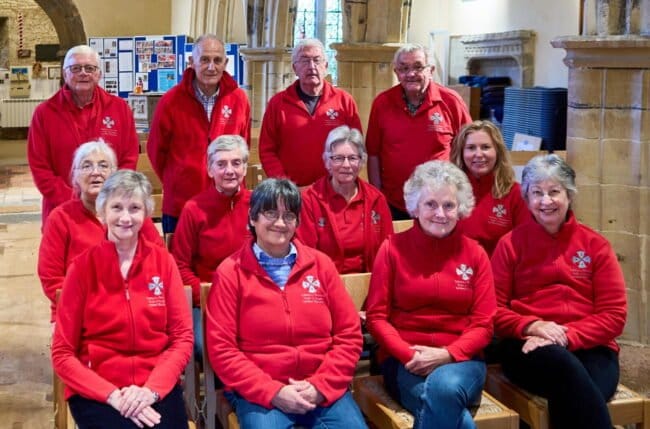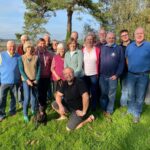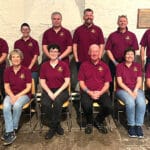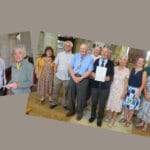The 1662 Diocesan Visitation returns for Westwood record that our bell is slatt i.e. cracked. If money was short in the parish, and bellfounders busy, this bell may not have been recast until 1677 when the treble bell was recast by John Lott II of Warminster and had the inscription
IOHN WALLIS GENT RICHARD HUNTLEY GENT CW IL 1677
CW stands for Churchwarden. The two on the bell, John Wallis and Richard Huntley, would have been responsible for ordering the bell and ensuring that they paid only for the metal used in the casting.
Churchwardens’ accounts for Westwood date from 1803 and from then until 1869 there are regular payments for the maintenance of the bells and for ringing. Bell ropes were a frequent expense. On Oct 31st 1803 the churchwardens paid G Latter for 4 bel Ropes wt 41 lb at 1/3 per lb £2/11/3 [£2.56]; buying bell rope by weight was not unusual. At Easter 1828 Mr Willm Taylor of Bradford was paid £1/14/6 [£1.73] for [a] New sett of bell ropes. Taylor and his descendants also supplied other churches in the area with bell ropes; their ropewalk was on Newtown, Bradford, on the site of The Ropewalk sheltered housing. In 1869 T. Bailey received 9/- [45p] for Bell Ropes &c. In 2013 a new set of ropes cost over £1,000.
Maintaining bells is a continual task, and entries for this include
1823 Repairing locks iron for the bells and other cappen [sic] for Bell Clapper 13/-
1830 pd for repairs for the Church and the Smiths work for Bells &c £1/15/5
1825 Lock & key to the Tower Door 1/6d
1830 pd for repairs for the Church and the Smiths work for Bells &c £1/15/5
1842 Wm Marchant for work to the Great [tenor] Bell – Pulleys – New Rope & fixings 10/-
1855 Repairing Tower Stairs £1/4/2
At Easter April 5th 1858 an Inventory of the Utensils of the Church at Westwood in the County of Wilts included The Four Bells.
1862 By cash for repairing Bells 12/7d
From The Trowbridge Advertiser of September 3rd 1864 we learn:
“Where there’s a will there’s a way.” A Bride and groom at Westwood wanted the bells, but the pulleys needed oiling, and they could not afford the oil. So the bride with that womanly perseverance that overcomes all obstacles sped her way to the [ground floor] belfry and proclaimed her own nuptials by lustily pulling at the bell. The villagers heard, came along, and rewarded the bride for her determination by helping her to ring, or rather toll, the bell, the bridegroom himself and the wedding party taking turns at the rope.
In 1878 The Church Rambler made the following sad observation:
Westwood . . . four bells, three of which are unfortunately cracked for which I believe the vandalism of a departed man of position in the neighbourhood who removed the bell ropes and converted them into wagon lines is largely responsible.
‘Church Rambler’ [aka Harold Lewis] recorded the inscriptions as below, in the same order as W. C. Lukis in An Account of Church Bells:
1. by John Lott
2. (cross) SANCTE ANNA TR
3 .(cross) SANCTE THOME ORA PRO NOBIS HI
4. as three
The bells may have been ‘clocked’, i.e. the clappers fastened to a piece of rope and shaken about in the bell, one of the best ways to crack a bell. Two years later fund raising for the bells started. The Wiltshire Times of Saturday September 11th 1880 reported
HARVEST THANKSGIVING – The collections which were made after each service and amounted to £4 15s 10d [£4.79] were given to the bell fund. The old bells are now taken down from the tower and will be replaced by new ones at the end of the year.
Despite the optimism in 1880 no bells were recast until 1884 when the treble was recast by Llewellins & James of Bristol, who had recast the tenor bell at Holy Trinity in 1881. The Westwood bell, like the Holy Trinity bell, would have been taken to Bradford Lock and travelled along the Kennet and Avon Canal to Bristol and thence to Llewellins & James’s foundry at Castle Green, Bristol. The inscription read:
CAST 1677
RECAST 1884
LLEWELLINS & JAMES BRISTOL
The Trowbridge Advertiser of July 31st 1885 reported that
In furtherance of the object begun some time ago of reinstating in good condition the bells of the parish Church [there was] a sale of work. Until one of the bells was recast and re-hung some time go all the four in the belfry were unsound, and almost, if not quite beyond use. It is now sought to obtain the requisite funds for recasting the remaining three bells, the cost of which, with new wood work and gearing is estimated at £110. A sale of work in aid of the church bells held on the Vicarage Lawn on July 28th raised £64 7s 8d.
A further article on November 27th 1886 reported on the dedication of the church bells and on April 27th 1889
The brightest festival of the year [Easter Day] was ushered in on Sunday by a merry peal from the Church bells.
The other three inscriptions on the recast bells were:
Second bell: [cross) SANCTE THOMA ORA PRO NOBIS H.I.
(on waist) LLEWELLINS & JAMES BRISTOL 1886
Third Bell: As second with on opposite side of waist W. R. WOLLEN RECTOR
Fourth Bell: [cross] SANCTA ANNA T.R. with, on opposite side of waist, W. R. WOLLEN RECTOR and below JOHN BOURNE CHARLES CROOK CHURCHWARDENS
There are rubbings of the inscriptions of both the four old bells and the L&J four, and all are in the Wiltshire Museum, Devizes. Those for the old bells were taken on 17th April 1876 by John Harris, a bell historian from St Albans who collected a great deal of material from Wiltshire and Dorset. On 9th August 1904 J.P.E. Falconer took rubbings of the four L&J bells.
The four bells were rung from the ground floor, and by the early 1970s had become very hard to ring. In 1979 the bells were sent to the Whitechapel Bell Foundry where they were recast into the present six bells and rehung in a new steel frame. The ringing room was moved higher up the tower which means the ropes have a very short draft. You still have to pull through though.
Only the tenor has an inscription:
SANCTE THOME ORA PRO NOBIS H.I.
WE WERE CAST FROM
THE METAL OF THE PREVIOUS FOUR BY
LLEWELLINS & JAMES OF BRISTOL
THE TREBLE CAST 1677, RECAST 1884
THE REMAINDER, MEDIEVAL, RECAST 1886
1979
SIMON GUY VICAR
DEREK WIGRAM } CHURCHWARDENS
LORNE BOND
The new bells are one of a group of light rings of six cast at Whitechapel the others
include Avebury, Wilts (1981) and Immanuel Episcopal Church on the Green, New Castle, Delaware, USA (1972 and 1973). The Avebury bells (tenor 4-2-20 cwt in D) were cast from an old ring of five. They are slightly heavier than those at Westwood and were augmented to eight in 2010 by Matthew Higby & Co. The New Castle bells were badly damaged in a fire in 1980 and recast by John Taylor bellfounders in 1982.
Like Charminster, Westwood has a devil, though not in the ringing chamber. The ‘the old lad of Westwood’ or ‘the devil of Limpley Stoke’ is a carved winged demon on the west wall of the nave, above the font. His mouth is still red and he is gnashing his fearsome teeth at the newly baptized. Underneath is a faint inscription ‘Resist me and I will flee’.
The bells have a pleasant, distinctive sound, but are placed rather low in the belfry and can hardly be heard in the village. That does not stop regular practices (Thursdays, all welcome), regular Sunday service ringing, and ringing for village events such as the Flower Show. Currently Westwood has an enthusiastic band of thirteen ringers, though only three come from the village. Other regulars come from both Wiltshire and Somerset, and we enjoy occasional exchanges with the South Wraxall ringers. Earlier this year the band came third in the Devizes branch 6-bell striking competition, and was the highest placed 6-bell tower in the competition.
Anne Willis
Tower Captain, Westwood





